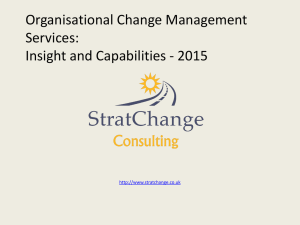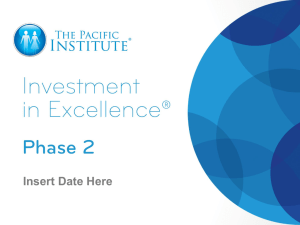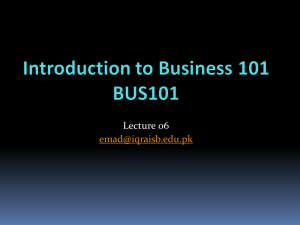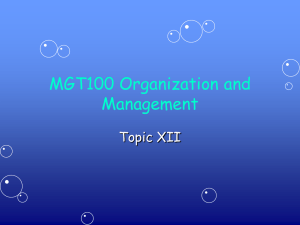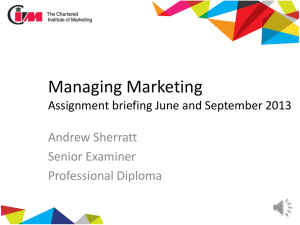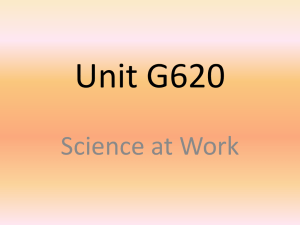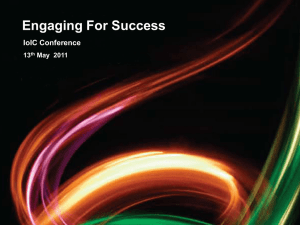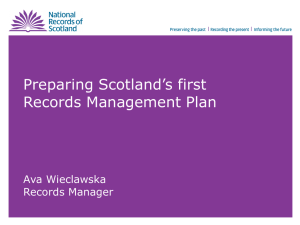Speaker Presentation
advertisement
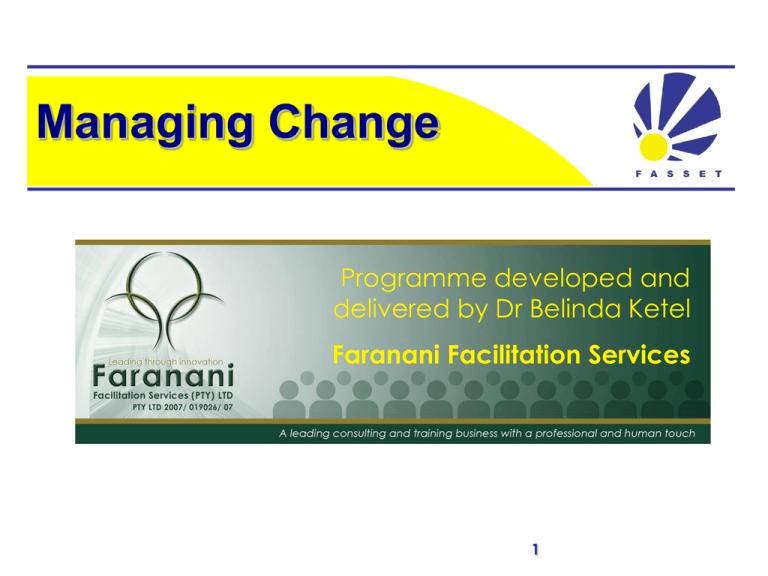
Managing Change Programme developed and delivered by Dr Belinda Ketel Faranani Facilitation Services 1 Programme 07h30-08h00 Registration 08h00-08h20 Fasset Welcome, Briefing and Introduction 08h20-09h30 The context for Change 09h30-09h40 Comfort Break 09h40-10h45 Implementing Change 10h45-11h05 Tea break 11h05-12h25 Adapting to Change 12h25-12h30 Fasset closure 12h30-13h00 Lunch 2 About this seminar The seminar aims to challenge Skills Development Facilitators (SDFs), Human Resource Professionals and Managers 3 Context for change • Understanding what change is • The role of change management in the organisation • Drivers of change • Effects of change • Critical success factors in change management • Planned vs. reactive change 4 Implementing change • Guiding principles of change management • Change management models • Stages in the Change Management process • Trends in change management • Factors in selecting a change management strategy • Change management strategies 5 Implementing change • Creating an organisational culture that embraces change management • Developing a change management plan • The role of the change agent • How HR/SDF can deliver change management results • Why change management often fails • Measuring the impact of change processes – results chain 6 Adapting to change • Creating resilient organizations • Do’s and Don’ts of change management • Consequences and mistakes in change management • Innovation practices to enhance change management sustainability • Managing risks in the change management process • Managing resistance to change – managing people’s fear 7 What is change? 1. The task of managing change 2. An area of professional practice 3. A body of knowledge 4. A control mechanism • The Change Process as Problem Solving and Problem Finding • The Approach taken to Change Management Mirrors Management's Mindset 8 Role of change in organisations 9 What does CHANGE feel like? Change three things…… 10 Own experience of CHANGE • What change processes have you experienced in your organisation in the last 2 years? • Share briefly in your groups – what was more positive / more negative about these changes? 11 Change is an episodic activity It starts at some point, proceeds through a series of steps, and culminates in some outcome that those involved hope is an improvement over the starting point…… 12 Thoughts on change • Change takes time, but quick-fixes are essential to make it happen • You can’t expect to get every-thing right, so expect mistakes - don’t be paralysed at the possibility of making them • If you wait until all the facts are in, they’ll be useless • The biggest risk is to avoid all risk 13 Drivers of change 1. Inadequate Financial Performance 2. Change In Strategic Objectives 3. End of the Product Development Life Cycle 4. New Technology 5. Mergers and Acquisitions 14 Triggers of change • External Triggers Globalisation Major political and social events New laws and regulations New technology Organisational growth and expansion Fluctuations in business cycles 15 15 Triggers of change • Internal triggers New leader with new management style New strategic plan Need to improve performance Need to save money or reduce debt Need to manage an increasingly diverse workforce Need to meet customer’s expectations of service Need to keep up with international and local trends 16 16 Critical success factors 17 Managing organisational change Common Characteristics of the Transition Stage Present State Vision • Confusion with roles, decision making, authority • Holding on to the past • Cynicism • Difficulty with ambiguity • Back-sliding to old behaviours • Skills/knowledge gaps 18 So what makes up a good change process then? 19 Change Management Matrix Pressure For Change Clear Shared Vision Capacity For Change Actionable 1st Steps Successful Change Bottom of the Basket Pulling in different directions – no results Frustration and muddled actions Nothing happens 20 Types of Change Behavioural Structural Technical Change Attitudes/ Values Change Structures/ Designs Change Production/ Methods New Behaviours New Relationships New Processes Performance Improvement 21 “Ten Commandments” • Analyse the organisation and its need for change • Create a shared vision and common direction • Separate from the past • Create a sense of urgency • Support a strong leader role • Line up political sponsorship • Craft an implementation plan • Develop enabling structures • Communicate, involve people, and be honest • Reinforce and institutionalize change 22 Planned and reactive change Planned Change: • This occurs when a change results from a deliberate decision to alter the organisation. • A company may wish to move from one structure to another and, thus, engage in a carefully constructed or orchestrated approach to alter the structure or functions of the organisation. 23 23 Planned and reactive change Planned change has three facets Incremental change: This is change of a relatively small scope, such as making a small modification in a work procedure. It is change involving minor improvements. Strategic change: This is change of a larger scale, such as the restructuring of an organisation. In strategic change, the organisation moves from an old state to a known new state during a controlled period of time. Strategic change usually involves a series of transitional steps. Transformational change: This is the most massive scope of change. With this change, the organisation moves to a radically different, and, at times, unknown future state. In this change process, the organisation’s mission, culture, goals, structure, and leadership may all change dramatically. 24 24 Planned and reactive change Unplanned Change • Alterations may occur as a result of imposed conditions. Such change may be unforeseen. Unplanned changes may be environmental, for instance, natural disasters. Government regulations and economic conditions may lead to abrupt and unexpected changes for organisations. • Whether forced or planned, but especially in the case of the latter, change needs to be managed, especially because it can be either disruptive or constructive 25 Why are most change initiatives not sustainable? 26 27 Change models 28 Change models 29 Change models 30 31 The learning organisation Personal Mastery Team Learning Mental Models The Learning Organisation Shared Vision Systems Thinking 32 ADKAR Model 33 ADKAR Model 34 Stakeholder involvement 35 The “laws” of change management systems • Areas of the highest leverage are often least obvious • Behaviour grows better before it gets worse • Cause and effect are not closely related in time and space • The cure can be worse than the disease • Dividing an elephant in half does not produce two elephants 36 The “laws” of change management systems • The easy way out usually leads back in • Faster is slower • The harder you push, the harder the system pushes back • There is no blame • Today’s problem come from yesterday’s solutions • You can have your cake and eat it too - but not all at once 37 Strategies for managing change • Directive • Expert • Negotiating • Educative • Participative 38 Creating an organisational culture that embraces change Assessment tools: • Organisational–type Inventory • Organisational Climate Questionnaire • Organisational Readiness Inventory 39 Designing a change management plan 40 Change agent responsibilities Change Agent analyses: • Existing problem / challenge • Current reality of team • Desired future state • Barrier preventing progress • Forces of the change • Goals of key stakeholders • Organisation’s strategy • Organisation’s readiness and capacity to change • Other changes in the organisation 41 Change agent roles • • • • • • • • The Facilitator The Designer The Project Manager The Educator The Marketer The Inspiration Agent The Systems Integrator The M&E expert 42 Change agent skills • Political skills • People skills • Systems skills • Business skills 43 Role of HR and SDF Future/Strategic focus Management of strategic human resources Management of transformation and change People Processes Management of organisational infrastructure (HR processes and systems) Management of employee contribution Day to day operational focus 44 Why change management fails?? • Miss-starts • Making change an option • Focus only on process • Focus only on results • Not involving the people expected to implement the changes • Delegate to outsiders • No change in reward system • Leadership doesn’t walk the talk • Wrong size • No follow-through 45 Measuring the IMPACT of change 46 Indicators for measurement • Baseline • Input • Output • Outcome • Impact • Process • Composite 47 Measuring the IMPACT of change 48 Measuring the IMPACT of change In your groups: • Identify take any e.g. of change from your organisation/s; • Plan a results chain for this change – use colour cards provided • Identify the IMPACT measures that are critical 49 Organisational resilience • Its NOT something you do, its something you ARE! • …..is the capacity for complex systems to survive, adapt and grow in the face of turbulent changes; • A resilient enterprise is risk intelligent , flexible and agile. 50 Organisational resilience 51 Organisational resilience How does it help an organisation? • Return to pre-disruption profits faster • Uses the event as an opportunity to improve its effectiveness • Reduce the cost of the disruption • Reduce exposure to unintended losses • Negate the requirement for increased regulation to meet expectations 52 Organisational resilience What does a resilient organisation look like? • Pulls together to work as a team in times of adversity • Knows what needs to be achieved • Has supportive networks with role players • Adapts quickly and with enthusiasm to challenges • Foresees developing threats 53 Organisational resilience Connections Optimism Unity Effective Communication Survivor instincts Interdependency Understanding Cohesion Ability to bounce back Shared vision Innovation Self reliance Flexibility Determination Preparation Strong spirit Awareness of S & W Strong social capital Vigilance Leadership Informed View Resourcefulness Learning Organisation Forward thinking approach Intuition Collaboration Situational awareness Exercises & practices Anti-silo mentality 54 Organisational resilience Five Principles 1. Leadership 2. Culture 3. People 4. Systems 5. Settings 55 Why people resist change • Fear of the unknown • Unaware of future dangers • Complacent • Unaware of benefits of change • Unable to deal with uncertainty • See change as a personal threat • Afraid own “kingdom” will be toppled • Cannot envisage future 56 The human response to change OVERT COVERT Unawareness Suppression Denial Guilt and questioning Projected aggression Anger, repulsion and selfrejection Bargaining Fight-flight-freeze Acceptance Connection and pro-action Resistance, malicious compliance and inertia Powerlessness, loss and despair Hope or resignation Ownership 57 Response to change characteristics Acceptance ACTIVE Anger E M O T I O N A L R E S P O N S E PASSIVE Bargaining Testing Stability Denial Immobilisation Depression 58 TIME Typical responses to change • Dis-engagement • Dis-identification • Dis-enchantment • Dis-orientation 59 Overcoming resistance 1. Mobilise commitment 2. Develop a Shared Vision 3. Foster consensus and competence 4. Spread revitalisation 5. Institutionalise revitalisation 6. Monitor and adjust strategies 60 Thank you …. Head Office (Cape Town): 206 Rosmead Ave, Wynberg, 7800, PO Box. 457, Plumstead 7801 Gauteng: Postnet Suite 469, Private Bag X51, Bryanston East London: Posnet Suite Number 187, Private Bag X3, Beacon Bay, 5205, South Africa. Ph: (021) 762 - 5742 Fax: (021) 762 – 9745 Email: marketing@farananiservices.co.za http://www.farananiservices.co.za (PTY) LTD 2007/019026/07 Accreditation No: Services Seta: 0866/02/11/05 Directors: Benedict Pillay, Deborah Williams, Zukiswa Mandlana Fasset Managing Change Seminar 61
